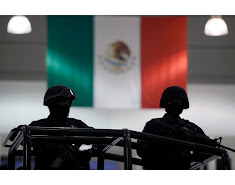The two defendants, Jose Olivera Beritan and David Valencia, are charged with involvement in several kidnapping and murder cases in San Diego in 2007. The two men were members of a Mexican gang, the Palillos, which once worked for the Tijuana Cartel (also known as the Arellano Felix Organization). But after the gang leader's brother was killed by the Tijuana command, the Palillos relocated to San Diego circa 2003. They used their knowledge of the Tijuana Cartel's US network to kidnap members who were living in the US. The gang also targeted drug dealers, businessmen, and police. While active in San Diego, the Palillos used several tactics commonly deployed by gangs across the border. They wore police uniforms when they kidnapped their victims. After collecting the ransom money, they did not always set the hostages free. In at least two cases, the captives were killed and their bodies dissolved in acid. The Palillos are so associated with this practice that the head of Baja California's Association for the Disappeared recently called for the FBI to investigate whether as many 20 people missing in Tijuana were killed and had their remains destroyed by the Palillos in the US. San Diego law enforcement cracked down on the organization in 2009, issuing charges against 17 members. Some of them fled to Mexico, but at least two were recaptured and extradited back to the US. Beritan and Valencia are the first of the suspected Palillo gang members to go on trial, in a case which has been cited by the FBI as an example of Mexico's drug violence spilling over the border. But other prominent cases of spillover violence between Tijuana and San Diego involve violence moving southwards rather than north. In the 1990s, the cartel recruited members of San Diego street gang Barrio Logan, also known as Calle 30, as mercenaries. The recruits received combat training and plenty of cash, and in return tortured, kidnapped, and killed on the cartel's behalf. Barrio Logan was reportedly behind the 1993 killing of Cardinal Juan Jesus Posadas Ocampo in 1993. In 1997, a Mexican judge charged seven Barrio Logan members with the attempted assassination of Jesus Blancornelas, the publisher of Tijuana-based investigative magazine Zeta. A 2011 report by Zeta magazine suggested that such recruitment campaigns are not a thing of the past. The piece argued that a former member of the Tijuana Cartel, now working for rival organization the Sinaloa Cartel, has enlisted members of Barrio Logan to cleanse the city of rival drug trafficking cells. One of those Barrio Logan recruits reportedly included Armando Perez, whom the magazine describes as one of San Diego's "most wanted" criminals, after he killed his wife in San Diego City College in 2010. The Zeta report suggests that the faction of the Tijuana Cartel allied with the Sinaloans sought to recruit US gang members, as a way of gaining an edge during Tijuana's cartel wars. This is a reminder that while it would be easy to label the ongoing Palillos trial as a clear example of Mexico's violence "spilling over" the border, such violence has apparently moved in both directions. It's worth noting that the Palillos shifted their operations to the US under very specific circumstances: they were in the unusual position of finding it safer to operate on US soil rather than Mexican. They could avoid their enemies, and act on their grudge against the Tijuana Cartel's leadership, targeting victims who were unwilling and unable to go to the police. The group were able to prosper in San Diego in large part by exploiting their knowledge of the Tijuana Cartel's network. The Palillos are, arguably, a unique phenomenon, rather than being indicative of an overall trend of spillover violence. The more realistic risk is not that Mexican gangs will pack up and move to the US, as happened in the Palillos' case, but that criminal organizations like the Tijuana Cartel will deepen their collaboration with US street gangs, using them to move, protect, and distribute drug shipments. The city of San Diego has as many as 81 street gangs, according to a report by local radio station KPBS. The extent to which the Tijuana Cartel is currently working with such gangs is currently unclear. But when discussing the risk of spillover violence, the deepening of business links between Mexico's cartels and US street gangs is a far more likely prospect than that of Mexican gangs choosing to relocate north of the border. Any gang that did so would probably eventually face a fate similar to the Palillos.













0 comments:
Post a Comment